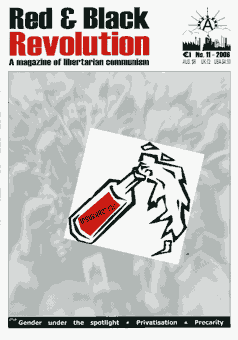Over 30 years of anarchist writing from Ireland listed under hundreds of topics
Organising with the T&G, and beyond?
In the UK union membership has been in steady decline for the past 25 years, not least due to how people are being employed - casualised labour, increased imposition of agency work, temporary, short term contracts & contracts of ‘self-employment’, along with the general lack of confidence in unions after years of complacency, compromises and defeats.One of the UK’s ‘big four’ unions, the Transport and General Workers Union (T & G), has sought to address this by adopting the model created by the American Service Employees International Union (SEIU) with its strategy of a national unit of professional ‘union organisers’ to target traditionally untouched areas of unionisation (precarious work in fragmented workplaces - most significantly in the UK Polish immigrant labour in the north & cleaners on London Underground and in the City). A lot of finances and resources have gone into ensuring this experiment is a ‘success’. The model is on a 3 year probationary period and for this year the organising unit should have recruited 10,000 new members.
On the surface this looks an impressive undertaking, especially the work done around the Polish workers in Crewe, yet we need to look closely just how they are operating and how much they encourage solidarity and militancy rather than compliance and acceptance of union leadership.
An organising team is typically made up of a team leader, an organiser and an organiser in training. These teams are usually from an activist or academic backgrounds (“because of their political commitment & willingness to work extra hours”) who go to workplaces to talk to and encourage workers to join the union. The more militant workers are encouraged to become organisers themselves who in turn organise in their respective workplaces.
The problem with this imposed structure is it is geared towards getting results. Essentially your energy and responsibility goes into meeting targets rather than meeting the needs of the workers (this is amplified when you do not share the same common conditions and problems at work). In effect organisers become the tools of the union teaching workers how to organise rather than being the delegates of workers in the workplace. It is an artificially informal hierarchy that re-imposes the formal hierarchy of the leadership, although a lot of effort is done on the ground to alleviate the impression the members answer to the union.
What is retained though is the leadership speaking on behalf of the workers, as evidenced with workplace grievances being dealt with directly by the ‘representation team’, sidelining any progressive dialogue between organisers and the people they’ve unionised, indicating the primary objective of ‘union organisers’ is to simply recruit new members. Plus this doesn’t bode well if we look at way the T & G handled the Gate Gourmet dispute, where the union stepped in to negotiate to get all the sacked workers reinstated only to sell them out in a compromised deal. Ironically the evening of a tube cleaners’ organisers meeting at T & G headquarters there was a picket outside by Gate Gourmet workers demanding their hardship pay be reinstated, having been withdrawn by the union. Despite all the fine words, activist commitment and workers’ militancy the union leadership will always have the last say.
The question then is can there be a genuine model for grassroots rank and file political activity and organising within a union setting, and if not what are the alternatives?
One initiative has emerged, on the back of the T & G tube cleaners campaign, called The Solidarity Collective – a group set up by people involved in the IWW, the Wombles, T & G organisers and other left groups to support ongoing workplace struggles independently of union hierarchy. How this develops is dependent on those involved but the intention is to link up with, and support the development of, autonomous and self organised workers struggles (not reliant on unions or political parties) as a means to foster forms of solidarity and collective strategies sadly missing in this current political climate. What is paramount is the recognition that we must work together in creating methods of confronting capital together. These are our collective struggles and we all have a part to play in them.
This article is from Red and Black Revolution 11, published October 2006

Read the rest of the articles in this issue online
Download the PDF file

